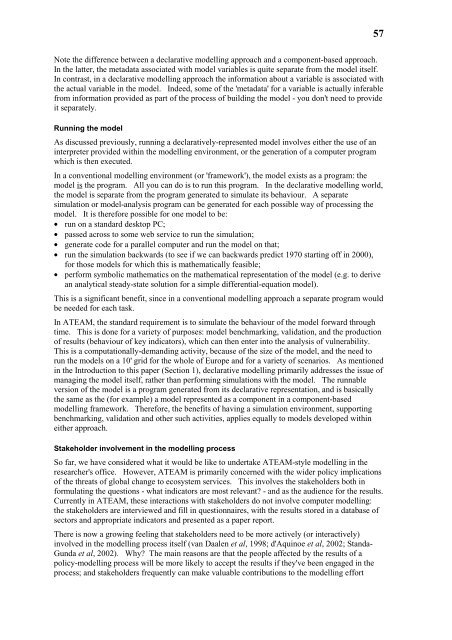pdf: 600KB - Potsdam Institute for Climate Impact Research
pdf: 600KB - Potsdam Institute for Climate Impact Research
pdf: 600KB - Potsdam Institute for Climate Impact Research
Create successful ePaper yourself
Turn your PDF publications into a flip-book with our unique Google optimized e-Paper software.
57<br />
Note the difference between a declarative modelling approach and a component-based approach.<br />
In the latter, the metadata associated with model variables is quite separate from the model itself.<br />
In contrast, in a declarative modelling approach the in<strong>for</strong>mation about a variable is associated with<br />
the actual variable in the model. Indeed, some of the 'metadata' <strong>for</strong> a variable is actually inferable<br />
from in<strong>for</strong>mation provided as part of the process of building the model - you don't need to provide<br />
it separately.<br />
Running the model<br />
As discussed previously, running a declaratively-represented model involves either the use of an<br />
interpreter provided within the modelling environment, or the generation of a computer program<br />
which is then executed.<br />
In a conventional modelling environment (or 'framework'), the model exists as a program: the<br />
model is the program. All you can do is to run this program. In the declarative modelling world,<br />
the model is separate from the program generated to simulate its behaviour. A separate<br />
simulation or model-analysis program can be generated <strong>for</strong> each possible way of processing the<br />
model. It is there<strong>for</strong>e possible <strong>for</strong> one model to be:<br />
• run on a standard desktop PC;<br />
• passed across to some web service to run the simulation;<br />
• generate code <strong>for</strong> a parallel computer and run the model on that;<br />
• run the simulation backwards (to see if we can backwards predict 1970 starting off in 2000),<br />
<strong>for</strong> those models <strong>for</strong> which this is mathematically feasible;<br />
• per<strong>for</strong>m symbolic mathematics on the mathematical representation of the model (e.g. to derive<br />
an analytical steady-state solution <strong>for</strong> a simple differential-equation model).<br />
This is a significant benefit, since in a conventional modelling approach a separate program would<br />
be needed <strong>for</strong> each task.<br />
In ATEAM, the standard requirement is to simulate the behaviour of the model <strong>for</strong>ward through<br />
time. This is done <strong>for</strong> a variety of purposes: model benchmarking, validation, and the production<br />
of results (behaviour of key indicators), which can then enter into the analysis of vulnerability.<br />
This is a computationally-demanding activity, because of the size of the model, and the need to<br />
run the models on a 10' grid <strong>for</strong> the whole of Europe and <strong>for</strong> a variety of scenarios. As mentioned<br />
in the Introduction to this paper (Section 1), declarative modelling primarily addresses the issue of<br />
managing the model itself, rather than per<strong>for</strong>ming simulations with the model. The runnable<br />
version of the model is a program generated from its declarative representation, and is basically<br />
the same as the (<strong>for</strong> example) a model represented as a component in a component-based<br />
modelling framework. There<strong>for</strong>e, the benefits of having a simulation environment, supporting<br />
benchmarking, validation and other such activities, applies equally to models developed within<br />
either approach.<br />
Stakeholder involvement in the modelling process<br />
So far, we have considered what it would be like to undertake ATEAM-style modelling in the<br />
researcher's office. However, ATEAM is primarily concerned with the wider policy implications<br />
of the threats of global change to ecosystem services. This involves the stakeholders both in<br />
<strong>for</strong>mulating the questions - what indicators are most relevant? - and as the audience <strong>for</strong> the results.<br />
Currently in ATEAM, these interactions with stakeholders do not involve computer modelling:<br />
the stakeholders are interviewed and fill in questionnaires, with the results stored in a database of<br />
sectors and appropriate indicators and presented as a paper report.<br />
There is now a growing feeling that stakeholders need to be more actively (or interactively)<br />
involved in the modelling process itself (van Daalen et al, 1998; d'Aquinoe et al, 2002; Standa-<br />
Gunda et al, 2002). Why? The main reasons are that the people affected by the results of a<br />
policy-modelling process will be more likely to accept the results if they've been engaged in the<br />
process; and stakeholders frequently can make valuable contributions to the modelling ef<strong>for</strong>t
















